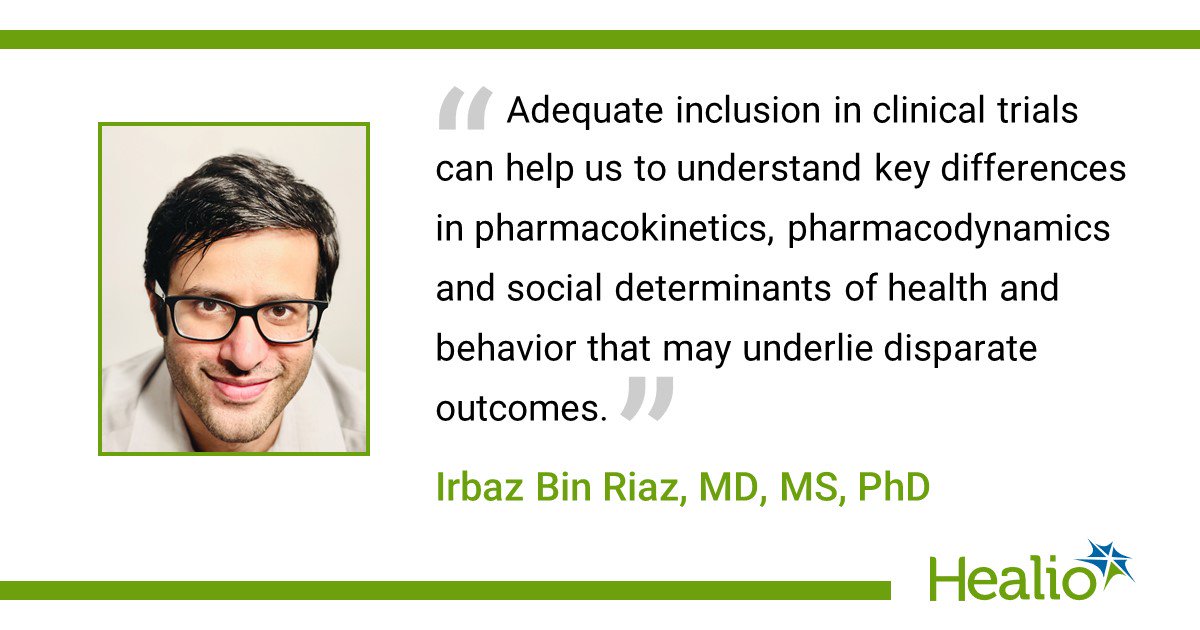Q&A: Lack of diversity in clinical trials hinders understanding of prostate cancer
Key takeaways:
- Disparities exist in prostate cancer clinical trials, diagnosis, care and outcomes.
- Better representation of minority populations in prostate cancer trials can lead to better understanding of the disease.
Ethnic and racial disparities exist and persist in many areas of oncology and must be addressed to promote and ensure health equity.
Prior research has shown that Asian, Black and Hispanic men are significantly underrepresented in prostate cancer clinical trials based on incidence of the disease among these groups.

Healio spoke with Irbaz Bin Riaz, MD, MS, PhD, research fellow in oncology Dana-Farber Cancer Institute and clinical informatics fellow at Mass General Brigham, to learn more about the disparities in not only prostate cancer clinical trials, but also diagnosis, care and outcomes.
Healio: How does clinical trial participation impact cancer research and/or practice?
Riaz: New drugs are tested in clinical trials before they become available for standard-of-care clinical practice. Hence, clinical trials are pivotal for making new options available to our patients. Patients participating in clinical trials can directly benefit if they have a delay in disease progression, improved quality of life, and longevity. However, it should be noted that patients who participate in clinical trials do an excellent service to other cancer patients by volunteering to participate. We owe significant progress and new treatment options to our patients who participated in clinical trials.
While it is evident that positive clinical trials impact clinical practice by making new treatments available, it should also be noted that even negative trials offer a lot of learning and insights for biomarker discovery. When pivotal clinical trials are lacking in diversity, their outcomes from a nonrepresentative sample are extrapolated to minority populations that may experience critical differences in efficacy or toxicity. This, in turn, can contribute to a lack of understanding of the disease and why/how it may affect men from underrepresented groups differently.
Healio: What does the current research say about health disparities in prostate cancer diagnosis, treatment, care and outcomes?
Riaz: There are documented disparities in the incidence, treatment and mortality of prostate cancer between Black and non-Black men. Notably, Black men are diagnosed with prostate cancer at nearly twice the rate of non-Hispanic white (NHW) men and Black men with local/regional prostate cancer are less likely to receive treatment with curative intent than NHW men. Further, the prostate cancer mortality rate is twice as high in Black men compared with NHW men.
The National Cancer Institute estimates that Black men have a 4.72% lifetime risk for dying of prostate cancer compared with a 2.86% risk among NHW men. Although biological differences may account for a portion of the disparity in overall prostate cancer survival, it has been suggested that improved access to care — including screening, follow-up and therapy — may effectively reduce this disparity.
It is important to note that one limitation of studies of prostate cancer incidence and mortality is that most data on Black men does not stratify them by country/region of origin — Black men are not a homogenous group and there may be differences in prostate cancer incidence and mortality for Caribbean, African and African-American men.

Similarly, certain subpopulations of Hispanic/Latino men have also been shown to experience higher prostate-cancer-specific mortality rates than non-Hispanic whites. Older men from racial minorities are also more likely to die prematurely of prostate cancer than younger men.
Healio: Are there any racial/ethnic considerations regarding genetic testing for prostate cancer?
Riaz: Prostate cancer is a genomically heterogeneous disease with notable variability in the genomic landscape across different racial/ethnic subgroup categories. For example, it was observed that Black men with metastatic prostate cancer had a higher likelihood of tumor mutations in the AR gene, as well as mutations in DNA-repair genes and actionable genetic mutations, compared to white or Asian men.
However, the current guidelines, in general, do not take into account race/ethnicity considerations when making recommendations for germline (genetic) testing, with one notable exception.
All patients with Ashkenazi Jewish ancestry should undergo germline testing regardless of other risk factors. For non-Ashkenazi Jewish patients, germline testing is recommended for patients with following criteria:
- family history of high-risk germline mutations (eg, breast cancer susceptibility gene BRCA1 and BRCA2, Lynch mutation);
- strong family history of prostate cancer (brother, father or multiple family members who were diagnosed with prostate cancer [but not clinically localized grade group 1 (table 2)] at less than 60 years of age or who died of prostate cancer);
- three or more cancers on the same side of the family, especially diagnoses ≤ 50 years of age: bile duct cancer, colorectal cancer, breast cancer, endometrial cancer, gastric cancer, kidney cancer, melanoma, ovarian cancer, pancreatic cancer, prostate cancer (but not clinically localized grade group 1), small bowel cancer or urothelial cancer;
- a personal history of high-grade (Gleason score ≥ 7) prostate cancer with Ashkenazi Jewish ancestry; one or more close relatives with breast cancer at age ≤ 50 or ovarian, pancreatic, or metastatic or intraductal prostate cancer at any age; or two or more close relatives with breast or prostate cancer (any grade) at any age; and
- personal history of regional (node-positive) or metastatic prostate cancer, particularly if intraductal or cribriform histology is observed on pathology.
Black men with prostate cancer are generally less likely to undergo germline testing than their white counterparts. This has implications on managing the disease, because identifying pathogenic variants in certain genes can affect decision-making regarding cancer screening in family members, treatment and cascade testing for patients who harbor them. Lack of diversity among germline testing cohorts may explain why variants of “uncertain significance” prevail at higher rates in racial/ethnic minorities.
Healio: How do you think underrepresentation can be addressed in prostate cancer clinical trials to ensure equitable enrollment?
Riaz: Efforts to promote minority inclusion in clinical trials, such as the 1993 NIH Revitalization Act and the reporting of demographic data on platforms like ClinicalTrials.gov through the 2007 FDA Amendments Act and Final Rule, have been valuable.
It is critical to acknowledge that racial and ethnic groups are not monolithic and to understand how social determinants of health vary within and across racial groups. Aside from race and ethnicity, several other markers of disparity must be tracked to determine which individuals within racial and ethnic minority groups experience more adversity than others and especially require attention (eg, how immigrant/foreign-born individuals from an underrepresented group may experience greater inequity than U.S-born individuals of the same race).
Similarly, most trials are restrictive in their eligibility criteria and are sometimes not representative of a real-world clinical setting. Data-driven artificial intelligence algorithms can evaluate eligibility criteria and predict the association of removing/broadening specific criteria with trial safety and patient response.
Prior studies have suggested that improved reporting of race and ethnicity may uncover additional, initially unreported enrollment disparities. Unfortunately, the current underreporting of racial and ethnic minority participation in clinical trials indicates a lack of data transparency and poor compliance with federal reporting mandates.
Journal editors should routinely ask for racial and ethnic demographic data and outcomes data reported by race and ethnicity in the clinical trials they publish. Precedents set by journals for manuscript publication were previously associated with improved data transparency in industry-sponsored clinical trial publications, and a race and ethnicity reporting policy could have a similar association.
The role of sponsors must be emphasized. The FDA has recommended that clinical trial sponsors develop a race and ethnicity diversity plan for the inclusion of underrepresented, clinically relevant populations and compliance with this recommendation during the submission of investigational new drug applications is crucial.
Thus, we propose a practical framework to mandate a level of racial and ethnic minority group accrual to studies necessary to establish clinical validity of the overall trial results for those populations. Because delays in discovery and evidence can be fatal for patients waiting for the next breakthrough, accrual to subpopulations can be designed to continue beyond the accrual required for the primary analysis.
In the long-term, recruitment of more diverse health care teams can help alleviate the mistrust and improve recruitment of URM populations.
Healio: Why is inclusion so important in prostate cancer clinical trials?
Riaz: Adequate inclusion in clinical trials can help us to understand key differences in pharmacokinetics, pharmacodynamics and social determinants of health and behavior that may underlie disparate outcomes. Until trials achieve a level of inclusion that provides adequate statistical power for underrepresented populations, there will be uncertainty in applying the risk-benefit ratio reported in these trials to the care of these populations.
References:
- Mahal BA, et al. N Engl J Med. 2020;doi:10.1056/NEJMc2000069.
- Riaz IB, et al. JAMA Oncol. 2023;doi:10.1001/jamaoncol.2022.5511.

